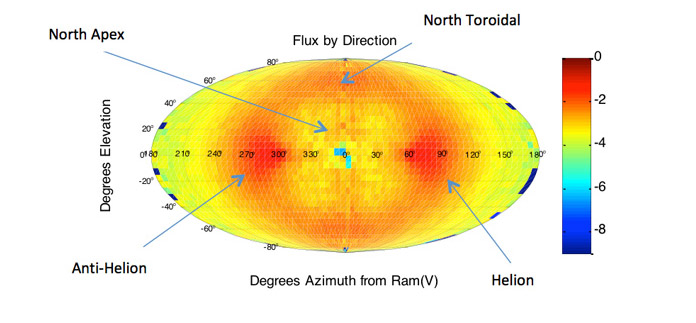Although NASA spacecraft encounter many drastic environmental conditions, one is particularly serious: the sporadic meteoroid environment, which can damage the vehicle and impede its mission. Thermal protection systems, radiators, sensors, solar panels, wiring, cables and so on can be damaged or even fail as a result of hypervelocity impacts or plasma generated from meteor impacts. To mitigate the risk associated with this dangerous environment, NASA developed the Meteoroid Engineering Model (MEM) to characterize the flux, density, speed and direction of meteoroids that a spacecraft will encounter throughout its trajectory.
MEM was developed because the meteoroid environment model commonly used by NASA and other U.S. government programs (found in the Space Station model, SSP-30425, and NASA TM-4527) suffered from several major deficiencies. The model
-
Did not match the known environment directionality (assumed isotropic flux)
-
Had an incorrect speed distribution derived from optical measurements where known biases were not considered, which lead to a skewed distribution that under-represented higher speed particles
-
Underestimated the number of craters — based on recent comparisons of the old model to returned hardware crater counts (underestimated vehicle risk by a factor of approximately 2
Uses
MEM can be used in all phases of design, from back-of-the-envelope calculations for basic shielding, to more extensive Design Analysis Cycles (DAC) that require detailed modeling provided by BUMPER, NASA’s primary assessment tool for meteoroid and orbital debris risk to spacecraft. It quantifies the probability of penetration and damage to spacecraft and vehicle components based on the orbit, orbital debris and meteoroid environment, and a finite element model of the shape and structure of the vehicle. MEM typically is used to produce an input meteoroid environment for BUMPER. Several NASA internal studies and the National Research Council have recommended MEM for spacecraft design.
How It Works
MEM produces a valid environment for meteoroids with masses in the threat regime, 1 microgram to 10 grams, and is applicable within the inner solar system (0.2 AU to 2 AU). The model generates evolved orbital distributions for meteoroids from cometary and asteroidal sources. Studies have shown that approximately 90 percent of meteoroids in near-Earth space are cometary in origin. Poynting-Robertson drag and crude collision effects have been implemented in the evolution process. Once the distributions are generated, Opik's formalism is used to calculate the spatial density or concentration of meteoroids based on the orbital elements from the distributions and the distance of the vehicle from the sun. The velocity vectors, speed and direction, relative to the vehicle also are computed at this time. Once spatial density and velocity are known, the flux for any direction may be calculated. Then, coordinate transformation routines are used to rotate meteoroids and spacecraft state vectors into an appropriate frame. Gravitational focusing and planetary shielding algorithms are incorporated for spacecraft in orbit around the moon, Earth or Mars. Finally, there are post-processing routines that calculate the fractional flux distributed by speed bin relative to the surfaces of a cubical spacecraft, averages and one sigma variations and construct a "threat igloo" file suitable for import into BUMPER.
Background

Radiant distribution as modeled by MEMR2 for a circular 1AU orbit (Earth) and a limiting mass of 10-6 grams.
The Meteoroid Environments Office (MEO) is sponsored by the Office of Safety and Mission Assurance and housed at Marshall Space Flight Center. It is the only U.S. government entity charged with defining and monitoring the meteoroid environment. MEO is responsible for producing the meteoroid model used in NASA spacecraft designs, generating meteor shower forecasts in support of manned and robotic spacecraft operations, participating in spacecraft anomaly investigations, and operating a network of meteor cameras and a meteor radar that monitor and track meteoroids entering Earth's atmosphere. Telescopes are used to monitor meteoroids impacting the lunar surface and to measure the meteoroid production of comets, the origin of 90 percent of all meteoroids near Earth. It is the complement to NASA's Orbital Debris Program Office at Johnson Space Center and the Near Earth Object Office at the Jet Propulsion Laboratory, which deal with orbital debris and asteroids.